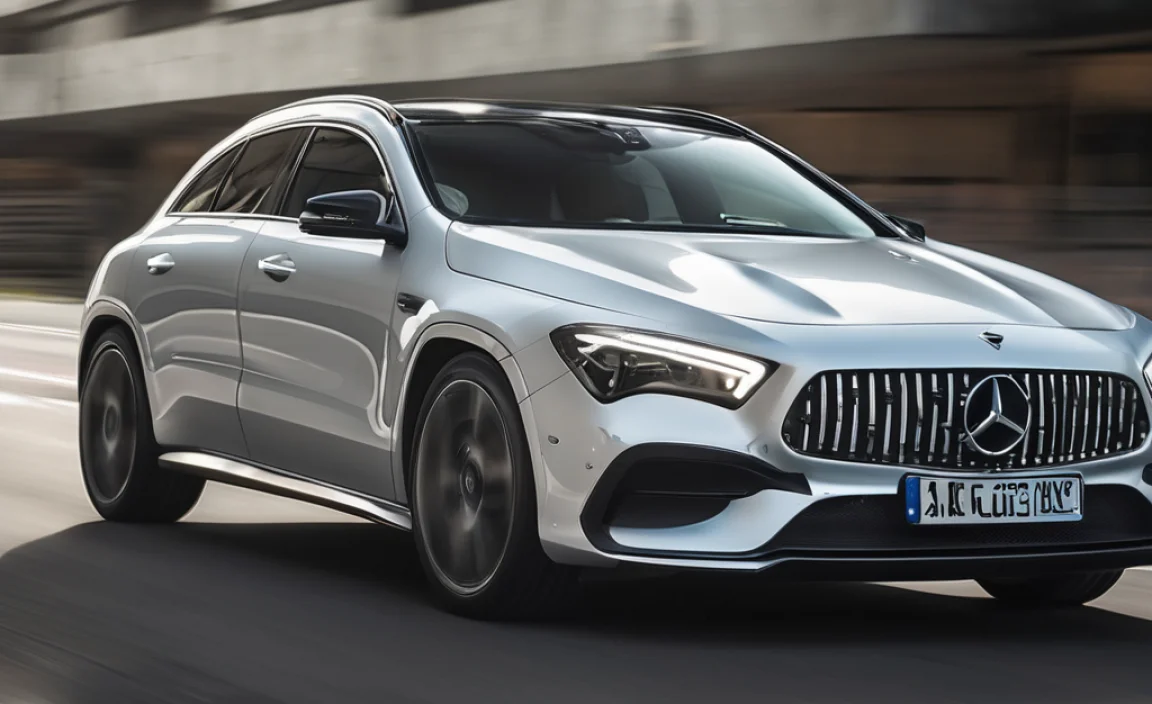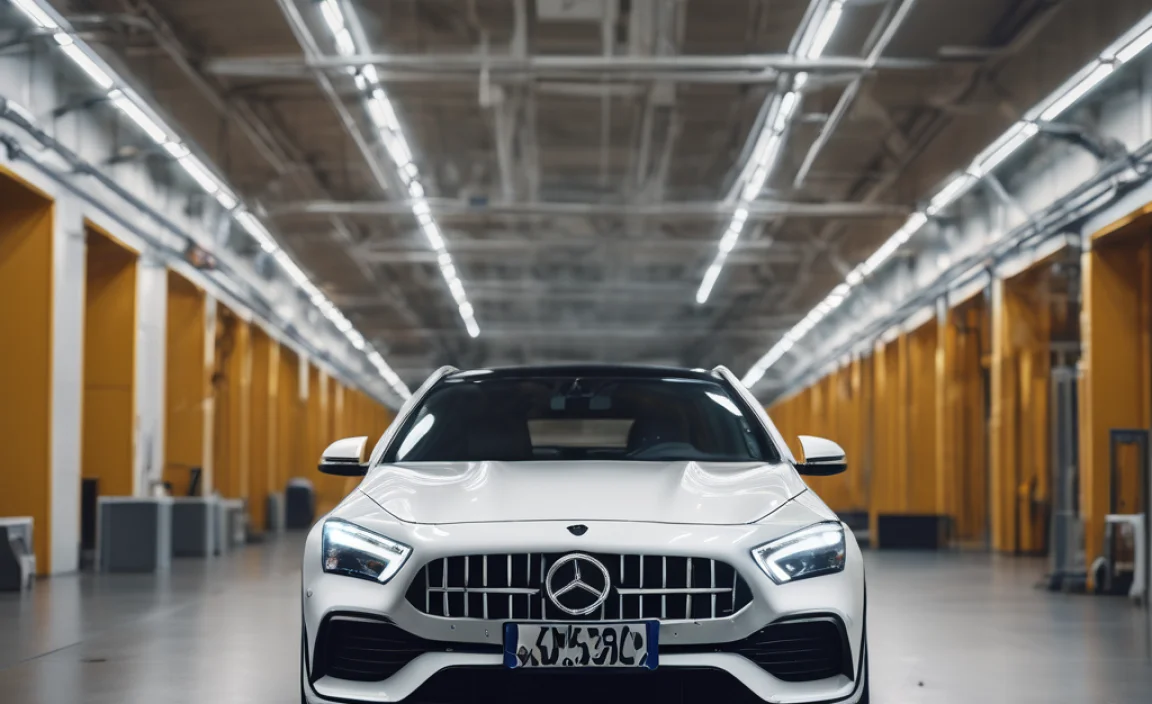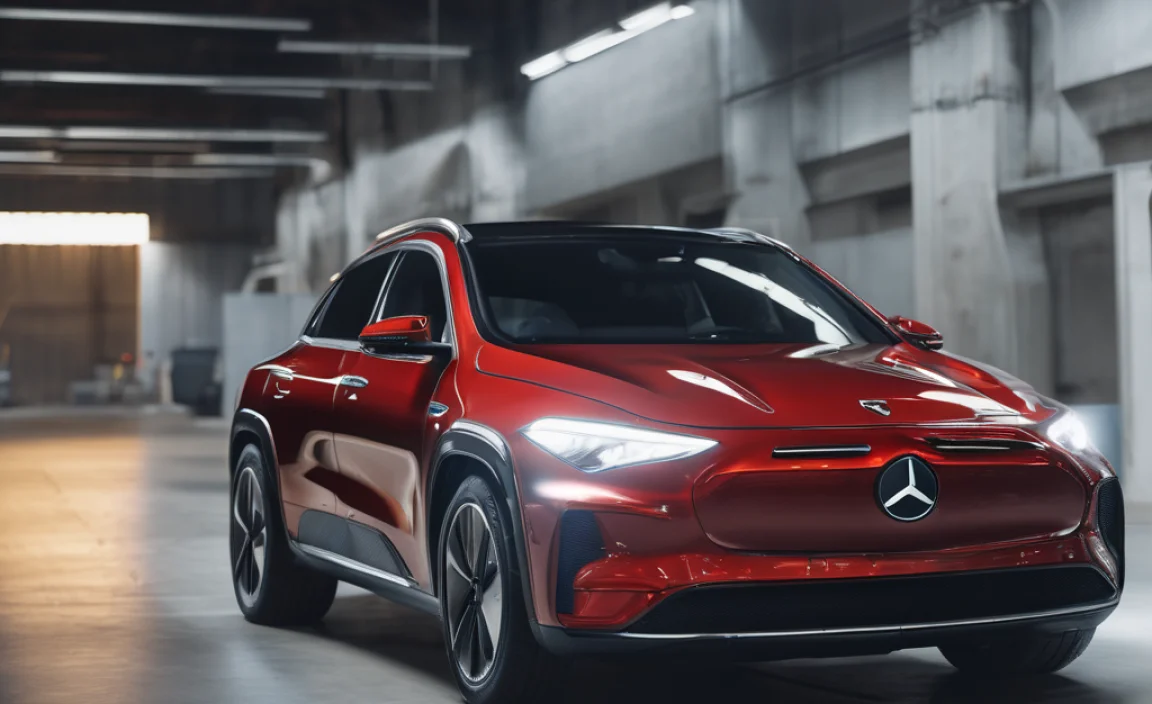The Mercedes-Benz GLA-Class electric variant offers a sophisticated blend of SUV versatility and zero-emission driving. This guide covers its key features, charging, maintenance, and what owners need to know for a smooth electric ownership experience.
Navigating the world of electric vehicles can seem a bit daunting at first, especially when it’s your first EV. You might be thinking about how to charge it, what’s different about maintenance, or if it’s really as simple as everyone says. The Mercedes-Benz GLA-Class electric variant is a fantastic choice, bringing the luxury and trusted engineering you expect from Mercedes-Benz into a sustainable, eco-friendly package. Don’t worry; we’ll break down everything you need to know in easy steps, so you can drive with confidence and enjoy every mile.
Understanding Your GLA-Class Electric Variant

The GLA-Class electric variant represents Mercedes-Benz’s commitment to an electrified future, offering a compact SUV that’s both stylish and practical. It’s designed to fit seamlessly into your daily life, whether you’re commuting, running errands, or heading out for a weekend adventure. What truly sets it apart is its advanced electric powertrain, delivering instant torque for responsive acceleration and a remarkably quiet ride. This means you get the premium feel of a Mercedes-Benz combined with the benefits of electric mobility.
Key Electric Features
When you choose the electric GLA-Class, you’re not just getting a car; you’re stepping into a technologically advanced experience. Here are some of the standout features:
- Electric Powertrain: Experience smooth, powerful acceleration thanks to the instant torque from the electric motor. This translates to effortless city driving and confident highway merging.
- Battery Technology: High-voltage lithium-ion batteries provide the energy, offering a competitive range for daily use and longer journeys. Mercedes-Benz’s battery management systems ensure optimal performance and longevity.
- Regenerative Braking: This smart system captures energy that would normally be lost during braking and deceleration, feeding it back into the battery. It not only improves efficiency but also reduces wear on your traditional brakes.
- MBUX (Mercedes-Benz User Experience): The intuitive infotainment system is enhanced for electric driving, providing real-time range information, charging station locations, and charging status updates.
- Advanced Driver Assistance Systems: Like its gasoline counterparts, the electric GLA-Class is equipped with a suite of safety and assistance features to enhance your driving experience and peace of mind.
What Makes it Different from a Gasoline GLA?
The core difference lies under the hood, or rather, where the hood used to be! Instead of an internal combustion engine, you have an electric motor powered by a large battery pack. This means no more gas stations, no oil changes, and a dramatically different maintenance schedule. Regenerative braking is another key distinction, as is the unique way the vehicle is managed and monitored through its advanced software and charging systems.
Charging Your GLA-Class Electric Variant

Charging is probably the most significant change when switching to an electric vehicle, but with the GLA-Class electric variant, it’s designed to be straightforward. There are three primary ways to keep your battery topped up:
1. Home Charging
This is the most convenient method, allowing you to wake up every morning with a “full tank.”
- Standard Outlet (Level 1): You can plug your car into a regular household wall socket using the portable charging cable provided. This is the slowest method but is useful for topping up overnight if you don’t drive very far daily.
- Dedicated Home Charger (Level 2): For faster charging, many owners opt for a professionally installed Level 2 charging station at home. This requires a 240-volt outlet (similar to what an electric dryer uses) and can significantly reduce charging times. Installation typically involves an electrician and can cost anywhere from $500 to $2,000 or more, depending on your home’s wiring and the charger unit itself. Check out resources from the U.S. Department of Energy for more details on charger types and installation considerations.
2. Public Charging Stations
These are found in diverse locations like shopping centers, parking garages, workplaces, and dedicated charging hubs. They typically offer Level 2 charging, and some are DC fast chargers.
- Level 2 Public Chargers: Similar to home Level 2 chargers, these are widely available and good for “topping up” while you shop or work. Charging speeds will vary by station.
- DC Fast Charging (Level 3): These are the fastest chargers available. They can add a significant amount of range in a short amount of time, often less than an hour for a substantial charge. They are ideal for longer trips when you need to recharge quickly. The availability of DC fast chargers is growing rapidly, making EV travel more feasible. Charging costs at public stations vary widely; some are free, while others charge by the kilowatt-hour (kWh) or by time.
Charging Times Explained
Charging times depend on the battery size, the charger’s power output, and how depleted the battery is. Here’s a general idea:
| Charging Level | Typical Power Output | Time to Charge (0-100%) |
|---|---|---|
| Level 1 (120V) | ~1.4 – 2.4 kW | 24-48+ hours (for full charge of a large battery) |
| Level 2 (240V) | ~3.7 – 11 kW | 6-12 hours (for a full charge) |
| DC Fast Charging (Level 3) | 50 kW – 350+ kW | 20-60 minutes (for 10-80% charge) |
Note: Actual charging times can vary based on specific battery capacity, ambient temperature, and charger efficiency.
Battery Health and Range Considerations

The battery is the heart of your electric GLA-Class. Mercedes-Benz designs its batteries for durability and longevity, and by following a few simple practices, you can help maintain its health and maximize your range.
Maximizing Your Range
Range anxiety is common for new EV owners, but with a GLA-Class electric variant, you’ll find its range quite practical for most daily needs. Here’s how to get the most out of it:
- Smooth Acceleration and Braking: Avoid rapid acceleration and harsh braking. Gentle driving is far more efficient. Utilize regenerative braking as much as possible.
- Maintain Moderate Speeds: Higher speeds consume battery power much faster. Driving at or slightly below the speed limit is generally more energy-efficient.
- Precondition the Cabin: Use the Mercedes-Benz app to set your desired cabin temperature while the car is still plugged in. This uses grid power instead of battery power to heat or cool the interior before you drive.
- Minimize Accessory Use: While the climate control system is optimized, very heavy use of heating or air conditioning can impact range.
- Proper Tire Inflation: Underinflated tires increase rolling resistance, making the car less efficient.
Battery Care Tips
Modern EV batteries are incredibly robust, but a few habits can benefit their long-term health:
- Avoid Frequent Deep Discharges: Try not to let the battery regularly drop below 10-20% charge.
- Avoid Frequent Full Charges to 100%: While it’s good to charge to 100% for long trips, for daily driving, charging to 80% or 90% can reduce stress on the battery over time. Most EVs allow you to set a charge limit in their software.
- Limit Exposure to Extreme Temperatures: While cars have battery thermal management systems, prolonged exposure to very high heat (like leaving a car in direct sun for days) or extreme cold can affect battery performance and longevity.
- Regular Software Updates: Mercedes-Benz frequently releases software updates that can improve battery management and charging performance. Ensure your vehicle’s software is up to date. You can often check for these updates via the infotainment system or through a dealer visit. The National Highway Traffic Safety Administration (NHTSA) also provides safety information related to vehicle technologies.
Maintenance for Your Electric GLA-Class

One of the biggest advantages of an electric vehicle is the significantly reduced maintenance compared to a gasoline car. Fewer moving parts mean fewer things to go wrong and less upkeep. Here’s what you can expect:
What You DON’T Need to Do Anymore
- No Oil Changes: Electric cars don’t use engine oil, so that recurring chore is gone forever.
- No Spark Plugs or Ignition System Maintenance: These are components of internal combustion engines and simply don’t exist in an EV.
- No Exhaust System Inspection: No mufflers, catalytic converters, or emission control systems to worry about.
- Less Brake Wear: Thanks to regenerative braking, your traditional brake pads and rotors will likely last much longer.
Essential Maintenance Tasks
While much simpler, your electric GLA-Class still requires basic maintenance:
- Tire Rotations and Balancing: EVs can have different weight distributions and torque applications, making regular tire maintenance crucial for even wear and optimal performance.
- Cabin Air Filter Replacement: This filter cleans the air you breathe inside the cabin and should be replaced periodically, typically once a year or as recommended in your owner’s manual.
- Brake Fluid Check and Replacement: Even though they wear less, brake fluid is still a critical safety component and needs to be checked and replaced at recommended intervals.
- Coolant for Battery and Powertrain Components: Electric vehicles manage battery temperature with a specialized coolant. This system should be inspected periodically for leaks and the coolant itself replaced according to the manufacturer’s schedule.
- Windshield Wiper Blades: Like any car, your wiper blades will need replacement when they become worn or streaky.
- General Inspections: Regular checks of lights, tires, and other visible components are always a good idea.
Scheduled Service Intervals
Mercedes-Benz has specific service intervals for its electric vehicles. Always refer to your owner’s manual for the most accurate information based on your specific model year. Generally, you’ll see service appointments recommended much less frequently than for a gasoline car, often around every 1-2 years or after a certain mileage (e.g., 15,000-20,000 miles), focusing on checks of essential systems like brakes, suspension, and the EV-specific components. The infotainment system will often alert you when service is due.
Troubleshooting Common EV Issues (Beginner Friendly)

Even with the simplicity of EVs, you might encounter minor issues. Here are a few common ones and how to approach them:
1. “My Range Seems Lower Than Expected.”
Possible Causes:
- Cold weather: Batteries are less efficient in the cold.
- Aggressive driving: Harsh acceleration and braking use more energy.
- High speeds: Aerodynamic drag increases significantly at highway speeds.
- Heavy accessory use: Running the heater or AC on high can reduce range.
- Tire pressure: Underinflated tires increase rolling resistance.
What to Do: Review the “Maximizing Your Range” tips above. Check your tire pressure. Observe your driving style. If the issue persists in moderate conditions and with gentle driving, it might be worth discussing with your dealer.
2. “The Car Won’t Charge.”
Possible Causes:
- Loose charging cable connection: Ensure the plug is fully inserted at both the car and the charger.
- Faulty charging station: If using a public charger, try another nearby charger or a different station altogether.
- Home charger issue: Check your home circuit breaker. If you have a dedicated charger installed, it might have a fault and require professional inspection.
- Car charging port issue: Inspect the port for visible debris or damage.
What to Do: Double-check all connections. Try a different charger if possible. If using a home charger, ensure your house’s electrical system is functioning correctly. If the problem persists, contact Mercedes-Benz roadside assistance or your dealer.
3. “The Infotainment System is Acting Up.”
Possible Causes:
- Software glitch: Like any complex computer system, the MBUX can occasionally freeze or behave erratically.
- Connectivity issues: Problems with Bluetooth or Wi-Fi connections.
What to Do: A simple restart can often fix minor glitches. Turn the car completely off, open and close the driver’s door (this often finalizes shutdown), wait a minute, and then restart the car. Ensure your phone is properly paired if using Bluetooth. If issues continue, check for MBUX software updates via your car’s settings or consult your dealer.
4. “Warning Light On Dashboard.”
Possible Causes: Many different systems can trigger a warning light. For EVs, it might relate to battery temperature, charging system faults, or drivetrain issues.
What to Do: Never ignore a warning light. Consult your owner’s manual to understand the specific symbol. If it’s a general service indicator, you can usually continue driving and schedule an appointment. If it’s a critical warning (e.g., a red brake warning or a drivetrain fault), pull over safely and contact roadside assistance.
Exploring Advanced Features and Technology
Your GLA-Class electric variant is packed with technology designed to make your driving experience more intuitive, efficient, and enjoyable.
Mercedes me Connect Services
The Mercedes me app connects your smartphone to your vehicle, offering a range of smart services:
- Remote Status Check: See your battery charge level, range, and tire pressure.
- Pre-Entry Climate Control: Set your cabin temperature remotely while the car is plugged in.
- Locate Your Vehicle: Find your car in a large parking lot.
- Send Destinations: Send navigation destinations from your phone to the car’s navigation system.
- Charging Management: Schedule charging times and monitor charging progress.
You’ll need to register for a Mercedes me account and link your vehicle to access these features. Always ensure you are using the official Mercedes-Benz app from your device’s app store.
Driver Assistance Systems
The electric GLA-Class comes with advanced driver assistance systems (ADAS) that enhance safety and convenience:
- Active Brake Assist
- Active Lane Keeping Assist
- Blind Spot Assist
- Adaptive Cruise Control (Distronic)
- Parking Assist (PARKTRONIC)
Familiarize yourself with how these systems work and their limitations. They are designed to assist, not replace, the driver. Always maintain your attention on the road and be prepared to take over control.
Regenerative Braking Modes
Your GLA-Class electric variant likely offers different levels of regenerative braking that you can select:
- D Auto: The system intelligently adjusts regeneration levels based on traffic, speed limits, and navigation data.
- D- Modulate: You can manually adjust regeneration levels using the paddle shifters behind the steering wheel.
- D- (Strong Regeneration): Maximizes energy recovery, allowing for significant deceleration and potentially “one-pedal driving” in some situations.
- D (Coasting): Minimal regeneration, similar to coasting in a conventional automatic car.
Experiment with these modes to find what suits your driving style best. Stronger regeneration can be very effective in stop-and-go traffic.
Frequently Asked Questions (FAQ)
Q1: How far can the GLA-Class electric variant travel on a single charge?
A: The estimated range varies depending on the specific model and battery configuration, but typically ranges between 250-300 miles on a full charge under ideal conditions. Always check the official specifications for your model year.
Q2: Is it expensive to charge an electric car?
A: Charging at home, especially overnight during off-peak hours, is usually significantly cheaper per mile than fueling a gasoline car. Public charging costs can vary, but often remain competitive with or cheaper than gasoline.
Q3: Will I need special insurance for an electric car?
A: Most standard auto insurance policies can be extended to cover electric vehicles. However, it’s always a good idea to inform your insurance provider about the switch to an EV, as premiums and coverage details might be adjusted. Parts and repairs for EVs can sometimes be